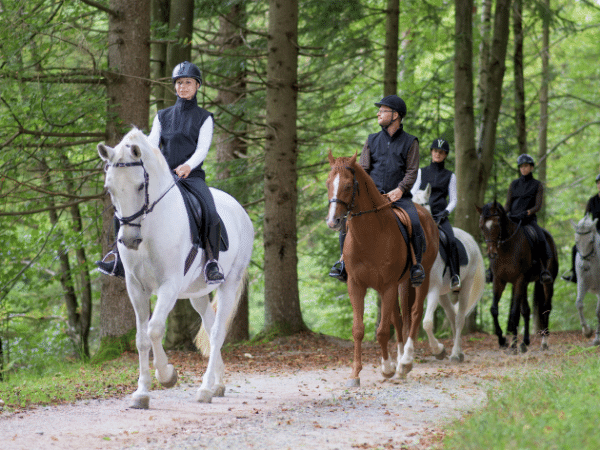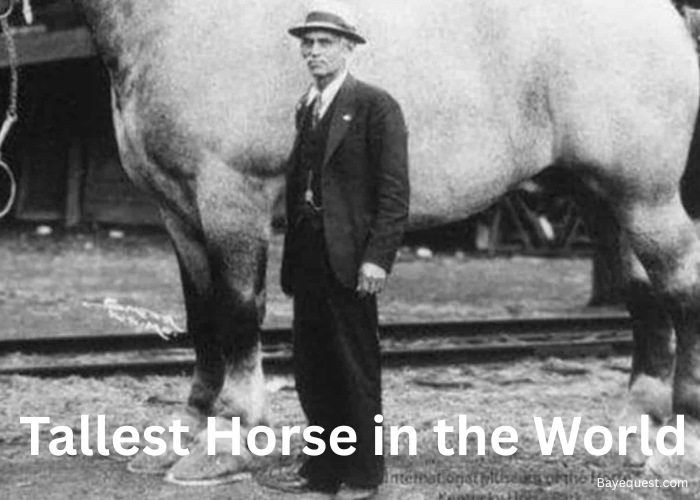The strong relationship between humans and horses isn’t ending soon. They are reliable pets, wonderful companions, and a reliable means of transportation. Moreover, horses are exceptional entertainers.
In return, we provide them shelter, food, and general care – a beautiful relationship if you ask most horse owners.
But is it? Does the relationship benefit horses as much as humans? Are they happy to live and work for us? Or is it a forced marriage?
Unfortunately, it’s a complex subject. So, we won’t go there. Instead, we want to focus on a more familiar topic – how horses feel about being ridden. Do they like it when we get on the saddle? Do they feel pain?
Why do we even ride them in the first place? Let’s take a deeper dive.
Are Horses Meant to Be Ridden?
This is the major talking point for animal welfare promoters and associations. Sadly, most people who use or work with horses never ask themselves this question.
The short answer is – NO. Horses aren’t meant to be ridden. This doesn’t mean we must never ride horses. On the contrary, most domesticated horses enjoy the experience and look forward to it. They’re devastated if you go a few days without taking them for a ride.
But is it one of the reasons horses exist? Unlikely, right? We may never know why the universe has horses. But it surely cannot be for human riding.
You only need to visit the free-roaming in the wild to understand this. Wild horses are herd animals who live in small, tight social groups. They travel through meadows, foraging and grazing with other herd members. They also play and sleep together.
Most importantly, wild and feral horses engage in courtships just like other animals. Then they foal colts and fillies, make families, and expand the herd.
Would a horse happily give up these benefits to carry humans on their backs? There’s only one answer – NO.
Domesticated horses are different, of course. Like dogs and cats, they grow up knowing the owner is part of their family. More importantly, they love to please their masters. Offering themselves to human riders is one way to enjoy a good time with the master.
Do Horses Like Being Ridden?
Now that we live with horses, a more appropriate question is whether your horse likes to be ridden. Do they enjoy it?
Fortunately, the answer this time is – YES. Not every horse enjoys being ridden. But most domesticated horses enjoy the experience just as much as humans and are visibly sad if you miss a few sessions.
Interestingly, some universities and research institutions have initiated research to determine whether horses enjoy being ridden. Early findings are positive, showing that domesticated horses enjoy being ridden. This is especially true when you treat the horse kindly and respectfully.
Read also: What is breaking a horse?
Signs that a Horse Likes (or Doesn’t Like) Being Ridden
Without conclusive evidence from scientific research, owners and trainers must rely on behavioral cues to determine whether a horse enjoys being ridden. By identifying these signs promptly, we can tell when the horse is enjoying the experience and respond appropriately.
The following are tell-tale signs your horse enjoys being ridden;
Observe the ears
If the ears are up, the horse is alert and receptive to new instructions. This is the first sign that they’re happy with the ride.
But horses can move their ears 180 degrees. So, you can further test their willingness by speaking to them and observing the ear’s direction.
They’re happy with the experience if the ears are erect and facing the rider. Meanwhile, pinned ears facing backward signify fear, aggression, pain, or stress. Be extremely cautious around the horse if you notice this behavior.
Drooped or hanging ears are also not a good sign. It shows the horse is bored or sleepy. So, you should wait for a better time.
Read also: Why do Horses Put Their Ears Back?
Observe the eyes
Horses are ready for a ride or enjoying the experience if their eyes are wide open, with the sclera (white part) not showing.
However, suspend the trip if the sclera shows. It means the horse is startled, afraid, or nervous. Similarly, hold off if the eyes dart rapidly back and forth. It’s a sign that the horse is anxious and planning to escape.
Half-closed eyes aren’t a good sign, especially if the horse has no eye problems. It often signifies exhaustion or lack of interest.
Closely monitor the tail
Specifically, keep an eye out for a relaxed or raised tail. Relaxed, dangling tails show the horse is at ease. It also means the horse is fine with the task.
Meanwhile, a raised tail signifies excitement and curiosity. So, it’s a good sign if the horse raises the tail as you approach. A gentle sway is fine, too. It’s a harmless process, often to deter flies.
However, you should think twice if the tail is clamped down. It’s a sure sign of fear or aggression, often followed by a bolt or kick. Alternatively, an irritated horse may violently switch or flick the tail. Suspend the ride if you notice this behavior.
Disrespectful behavior
Finally, a horse is excited for the ride if they follow your commands. Meanwhile, they may not be keen on the adventure if they appear disrespectful.
For example, your horse may be sending a warning if they graze when being ridden. It’s a sign of rebellion and a message to reconsider your priorities.
Similarly, the horse sends the wrong signal if walking too slowly, despite your commands. Though it’s a punishable behavior, the horse may simply be expressing their dissatisfaction. Maybe they’re too tired for the ride.
Lastly, horses can act out in several ways during riding. For example, you may witness bucking, rearing, taking off, or bolting. These are signs the horse is not happy about the ride.
Why a Horse May Not Like Being Ridden
Horses can be uncomfortable with being ridden for many reasons. Finding out why is the first step to getting a lasting solution. So, let’s explore the most common reasons;
Ill-fitting tack
An ill-fitting tack is the most common reason a horse may not enjoy a riding adventure. For instance, pitting a pony saddle on a draft horse is asking for trouble. The horse cannot move freely if the saddle tree doesn’t fit the curvature on the horse’s back. Moreover, the rider may be forced to lean forward, placing extra weight on the horse’s nimble front limbs.
Thankfully, most tack stores offer fitting clinics, often free of charge. Take advantage of this resource to find the perfect tack for your horse. The store will consider the type and size of the horse. Additionally, share your goals so they can take that into account.
The “wrong” rider
Yes, horses can act out and even refuse to ride if uncomfortable with the rider. But first, they’ll give you a few hints.
For example, horses know when the rider is too big and often show it. For instance, the horse may exhibit restlessness or hesitation if they believe the rider is too heavy. They may even attempt to escape. So, always find a horse that matches your size.
Similarly, a mild bit in large hands is more painful than a large one in small hands. Therefore, consider a bigger horse or exercise restraint.
Poor prep work
Prepping the horse or the ride helps in many ways. It alerts the horse about the upcoming activity, like stretching before heading on a trek.
Moreover, the rider may uncover injuries and twisted hairs that would otherwise cause a painful ride.
Begin with grooming while paying attention to the horse’s reaction. Flinching is often a sign of pain.
Next, rub your stronger hand against the horse’s back to check for signs of trouble. For example, a bumpy or sore skin requires attention before you resume riding.
Check the saddle and saddle pad, too. A bumpy or uneven saddle or pad can cause discomfort, resulting in a painful ride.
Poor riding habits
Unfortunately, most people never get professional training before riding a horse. Either they find a means through trial and error or rely on a few online articles and videos.
While you can learn a lot from both resources, professional training is the surest route to safe riding. You’ll learn what to do and what to avoid. But more importantly, you’ll learn to observe the horse’s behavioral cues.
For example, you must know how to sit and where to sit. Otherwise, the horse would be uncomfortable. Similarly, you must know when to partially stand in the stirrups or risk injuring your horse.
Post-riding care
Horses are intelligent animals with excellent memory. They keep track of how you treat them and reciprocate in kind. So, how you treat the horse after the ride determines how they react the next time you feel like riding.
For example, horses are hesitant to go on another ride if you never remove the tack after your ride. Similarly, horses get sweaty during rides, causing the skin to itch. You’d be wise to brush them and help them overcome the pain. Otherwise, they may not be so cooperative next time.
Finally, the frog accumulates dirt and rocks during rides, causing significant pain. Attending to them or promptly calling the farrier ensures a more memorable experience.
Interesting read: How to Read Horse Body Language.
How to Ensure the Best Riding Experience for the Horse
If you love the horse, there are several ways to make riding more bearable. The following are a few proven tips to consider;
Ensure the horse isn’t in pain
Horses are silent sufferers who can go days or weeks without vocalizing pain. But that doesn’t allow you to ride a horse in pain. It’s unethical and dangerous. Inspect the horse for injuries or underlying illnesses and only proceed if the animal is pain-free.
More learning, less punishment
Popular horse training techniques include punishments for disrespectful behavior. Often, it’s a painful and frightening stimulus applied after the horse errs. Unfortunately, negative reinforcements don’t always work. Instead, owners should focus on learning and understanding their horses to better respond to their needs.
Consider professional assistance
Beginners are understandably excited to saddle up and get on their first ride. Unfortunately, novice riders are prone to mistakes that may confuse, frustrate, or inadvertently punish the horse. Therefore, you should consider professional training.
Understand the horse’s skill limit
Not all horses are the same. They have different capabilities depending on the breed, size, age, and training. More importantly, two riding horses may have different levels of training. Don’t drag your horse into stunts and maneuvers beyond their abilities. It’s frightening and a big injury risk.
Master the 3Fs
The horse’s life revolves around three Fs – Friends, Forage, and Freedom. They need friends for company and companionship and forage for energy. Then, they also need freedom to explore their wild tendencies. Unfortunately, most owners chain horses to the barn all day, depriving them of freedom. This can result in poor behavior.
Interesting read: Do Horses Love Music?
FAQs
Why do horses let us ride them?
Horses allow us to ride them because they’re trained for it. Moreover, it’s now an expectation. The good news is that most domesticated horses are happy to be ridden, provided we treat them kindly and respectfully. Nonetheless, riders must learn when to and when not to get on the saddle.
Do horses suffer when we ride them?
Yes and no. Mature domesticated horses in good health are generally happy to be ridden and enjoy the experience. They even look forward to it. But can we say the same about young or old horses in poor health? Unfortunately, not. For these horses, riding is unpleasant and even painful.
Final words
Horses are comfortable being ridden as long as we treat them kindly and respectfully. They enjoy the experience and benefit from the exercises.
However, this doesn’t give us the leeway to ride every horse. Instead, ensure the horse is old enough, healthy, and prepared for the ride. Most importantly, ensure they’re not in pain.
Also, check out our article on equinophobia to understand how to build trust and confidence with horses, making the riding experience safer and more enjoyable for both you and the horse.








